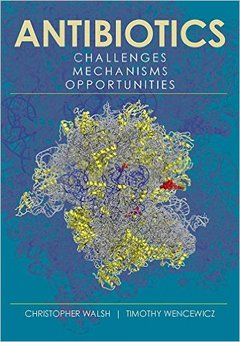Antibiotics (2nd Ed.) Challenges, Mechanisms, Opportunities ASM Books Series
Auteurs : Walsh Christopher, Wencewicz Timothy

A chemocentric view of the molecular structures of antibiotics, their origins, actions, and major categories of resistance
Antibiotics: Challenges, Mechanisms, Opportunities focuses on antibiotics as small organic molecules, from both natural and synthetic sources. Understanding the chemical scaffold and functional group structures of the major classes of clinically useful antibiotics is critical to understanding how antibiotics interact selectively with bacterial targets.
This textbook details how classes of antibiotics interact with five known robust bacterial targets: cell wall assembly and maintenance, membrane integrity, protein synthesis, DNA and RNA information transfer, and the folate pathway to deoxythymidylate. It also addresses the universe of bacterial resistance, from the concept of the resistome to the three major mechanisms of resistance: antibiotic destruction, antibiotic active efflux, and alteration of antibiotic targets. Antibiotics also covers the biosynthetic machinery for the major classes of natural product antibiotics.
Authors Christopher Walsh and Timothy Wencewicz provide compelling answers to these questions:
- What are antibiotics?
- Where do antibiotics come from?
- How do antibiotics work?
- Why do antibiotics stop working?
- How should our limited inventory of effective antibiotics be addressed?
Antibiotics is a textbook for graduate courses in chemical biology, pharmacology, medicinal chemistry, and microbiology and biochemistry courses. It is also a valuable reference for microbiologists, biological and natural product chemists, pharmacologists, and research and development scientists.
Preface ix–x
Section I Challenges for Antibiotics 1
1 Antibiotics: Initial Concepts and Considerations 4
2 Major Classes of Antibiotics and Their Modes of Action 16
Section II Mechanisms: Antibiotic Action by Bacterial Target Class 33
3 Assembly of the Peptidoglycan Layer of Bacterial Cell Walls 36
4 Antibiotics That Block Peptidoglycan Assembly and Integrity 68
5 Antibiotics That Disrupt Membrane Integrity 102
6 Antibiotics That Block Protein Synthesis 114
7 Antibiotics That Target DNA and RNA Information Transfer 148
8 Antibiotics That Block Biosynthesis of the DNA Building Block Deoxythymidylate 164
Section III Mechanisms: Bacterial Resistance to Antibiotics 177
9 Bacterial Antibiotic Resistance: Overview 180
10 Antibiotic Resistance: Modification or Destruction of the Antibiotic 198
11 Antibiotic Resistance via Membrane Efflux Pumps 220
12 Resistance via Target Modification 230
13 Tuberculosis: A Formidable Challenge for Antibiotic Therapy 252
Section IV Mechanisms: Antibiotic Biosynthesis 273
14 Antibiotic Biosynthesis: Principles 276
15 Biosynthesis of Peptide Antibiotics 288
16 Biosynthesis of Polyketide Antibiotics 320
17 Biosynthesis of Oligosaccharide, Isoprenoid, and C-P Antibiotic Classes 344
Section V Opportunities 363
18 Underexploited Pathways and Targets for Antibiotics 366
19 Prospects for New Molecules and New Targets 398
References 421
Index 455
Date de parution : 02-2016
Ouvrage de 477 p.
17.8x25.2 cm
Thèmes d’Antibiotics :
Mots-clés :
action; antibiotics; concepts; modes; ii; major; initial; molecules; underexploited


